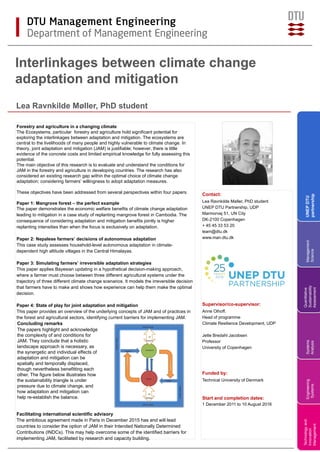
Forestry agriculture climate change JAM
- 1. Forestry and agriculture in a changing climate The Ecosystems, particular forestry and agriculture hold significant potential for exploring the interlinkages between adaptation and mitigation. The ecosystems are central to the livelihoods of many people and highly vulnerable to climate change. In theory, joint adaptation and mitigation (JAM) is justifiable; however, there is little evidence of the concrete costs and limited empirical knowledge for fully assessing this potential. The main objective of this research is to evaluate and understand the conditions for JAM in the forestry and agriculture in developing countries. The research has also considered an existing research gap within the optimal choice of climate change adaptation; considering farmers’ willingness to adopt adaptation measures. These objectives have been addressed from several perspectives within four papers. Paper 1: Mangrove forest – the perfect example The paper demonstrates the economic welfare benefits of climate change adaptation leading to mitigation in a case study of replanting mangrove forest in Cambodia. The consequence of considering adaptation and mitigation benefits jointly is higher replanting intensities than when the focus is exclusively on adaptation. Paper 2: Nepalese farmers’ decisions of autonomous adaptation This case study assesses household-level autonomous adaptation in climate- dependent high altitude villages in the Central Himalayas. Paper 3: Simulating farmers’ irreversible adaptation strategies This paper applies Bayesian updating in a hypothetical decision-making approach, where a farmer must choose between three different agricultural systems under the trajectory of three different climate change scenarios. It models the irreversible decision that farmers have to make and shows how experience can help them make the optimal decision. Paper 4: State of play for joint adaptation and mitigation This paper provides an overview of the underlying concepts of JAM and of practices in the forest and agricultural sectors, identifying current barriers for implementing JAM. Facilitating international scientific advisory The ambitious agreement made in Paris in December 2015 has and will lead countries to consider the option of JAM in their Intended Nationally Determined Contributions (INDCs). This may help overcome some of the identified barriers for implementing JAM, facilitated by research and capacity building. Technologyand Innovation Management Engineering Systems Systems Analysis Interlinkages between climate change adaptation and mitigation Lea Ravnkilde Møller, PhD student Contact: Lea Ravnkilde Møller, PhD student UNEP DTU Partnership, UDP Marmorvej 51, UN City DK-2100 Copenhagen + 45 45 33 53 20 leam@dtu.dk www.man.dtu.dk Supervisor/co-supervisor: Anne Olhoff, Head of programme Climate Resilience Development, UDP Jette Bredahl Jacobsen Professor University of Copenhagen Funded by: Technical University of Denmark Start and completion dates: 1 December 2011 to 10 August 2016 Quantitative Sustainability Assessment Management Science UNEPDTU partnership Concluding remarks The papers highlight and acknowledge the complexity of and conditions for JAM. They conclude that a holistic landscape approach is necessary, as the synergetic and individual effects of adaptation and mitigation can be spatially and temporally displaced, though nevertheless benefitting each other. The figure below illustrates how the sustainability triangle is under pressure due to climate change, and how adaptation and mitigation can help re-establish the balance.